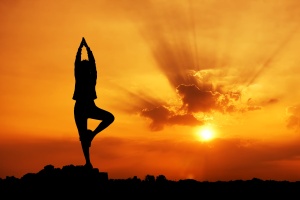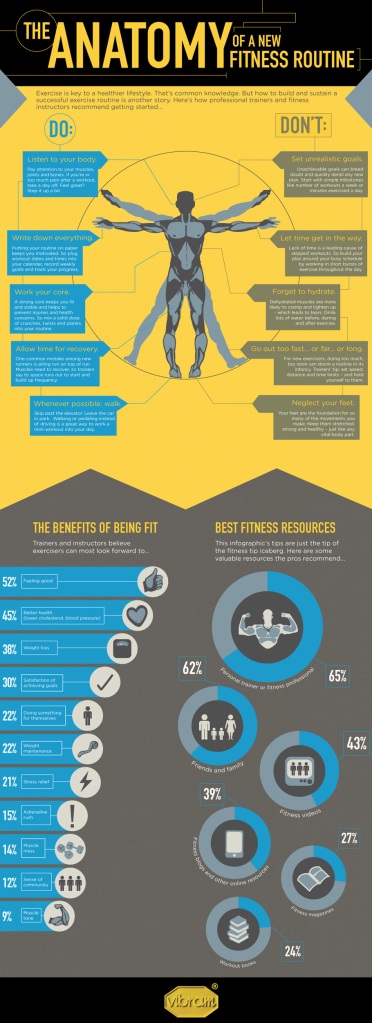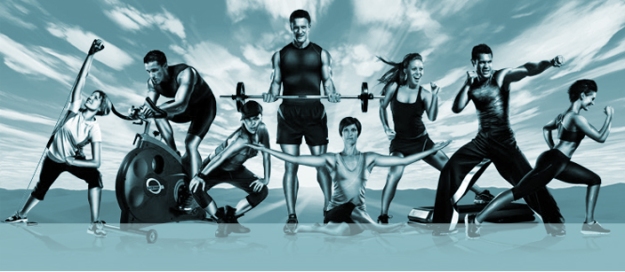With our modern day sedentary lifestyle strongly influencing our health in various ways, one of the most important elements of taking care of our bodies and working against the downsides of the modern luxuries (like being able to do almost all of our daily tasks from our desk) is exercise. Fitness and exercise are often talked about, but what they really mean and how they work often remains unclear. The purpose of this new Care for the Body blogpost is to introduce and give a short overview on the topic of fitness, which will be followed by several more detailed posts on specific aspects of fitness like strength training, cardio-training, flexibility/mobility training, etc.
First of all one needs to understand what the dangers of the sedentary lifestyle are. Our evolution has now reached a point where one of the biggest dangers to our health is coming from sitting too much and moving too little. The conditions that are caused by a lack of sufficient physical activity are sometimes referred to as hypokinetic diseases (hypo: lack of; kinetic: movement). These include all kinds of cardiovascular diseases (related to our heart and blood system), some types of cancer, back problems, diabetes and many other.
Now, if we understand that not being active enough is the cause of or a factor in many diseases, bad mood and even psychological problems, then – if our concern is health and well-being – we should get more active and fit, moving a lot in order to get out of that hypokinetic state most of us are in.
Below a video about the benefits of even a little bit of exercise during the day as opposed to doing nothing but sitting all day long.
Fitness colloquially means to be in a good shape and to be healthy.
Some people associate the word fitness with only running or with only strength training which reduces the meaning to only one of the aspects of fitness.
Fitness means being fit for life and its many physical challenges (even though there are also many other challenges that we are not talking about in this blogpost) and it includes a wide range of aspects.
The most important health-related aspects of fitness arguably are:
- Muscular strength and endurance
- Cardio-respiratory endurance
- Flexibility/Mobility
- Coordination and Balance
Some lists add body composition (the ratio between lean tissue like muscle and bone and fat tissue in the body).
Apart from those there are other aspects to fitness like speed, power, agility and reaction time, but one could argue that there are a little bit less relevant for general health and fitness.
There are training systems and philosophies like CrossFit that have become very popular over the last years that emphasize a wide range of aspects of fitness. Have a look here for CrossFit’s definition on fitness (on the site you can also download a pdf where all the CF aspects of fitness are listed and explained).
Let’s have a quick look at the above stated aspects of fitness (there will be subsequent blogposts with more information and videos on these, too):
Strength
Strength is the ability of a person to exert force on physical objects using muscle and is needed for all our basic human activities. Whether we walk, run, jump, lift something up or do other work, we need adequate physical strength to do so.
Strength can be trained in different ways, though most effectively through a well planned strength training program with weights and bodyweight exercises.
Strength training has innumerable benefits, such as:
- Increased metabolism (muscle tissue is metabolically active while fat tissue isn’t, so when you improve your body composition through strength training your metabolism improves, too)
- Increased muscle and bone strength (is necessary for all everyday activities; works against natural decline in muscle and bone mass that begins around age 25 in human beings (see article “Is sarcopenia ruining your life?”); prevents osteoporosis)
- Increased flexibility and coordination (strength training exercises through a full range of motion have shown to increase flexibility; they also improve both inter- and intramuscular coordination, meaning that muscles become more efficient and work together better)
- Prevention of injuries through the strenghtening of the muscles that support the other structures in the body (bones, tendons, ligaments, etc.)
- Better insulin sensitivity (the body is able to control blood sugar levels with less insulin and puts less stress on your pancreas)
- Lower cholesterol: (training helps lower LDL (bad cholesterol) levels and triglyceride levels and raise HDL (good cholesterol) levels)
Conclusion: Find a competent trainer and start your own regular strength training program! It will boost your overall fitness! But: Don’t forget to also do some cardio and flexibility training!
More information on strength training will come in subsequent posts.
Cardio-respiratory endurance:
Cardio-respiratory endurance refers to the ability of the heart and lungs to absorb, transport, and utilize oxygen over an extended period of physical exertion.
So called “cardio” exercises are low-intensity exercises that depend primarily on the aerobic energy-generating process.
Popular examples are:
- Walking
- Jogging
- Swimming
- Cycling
- Jump Rope (Ropeskipping)
Aerobic exercises have been recommended as part as a health-related fitness program for a long term due to their extense benefits on our cardio-respiratory capacity like making for a decreased resting heart rate, a reduced blood pressure, an increased heart volume, increased resting and maximum stroke volume, an increased maximum oxygen consumption and many more.
Since our heart is also a muscle, it needs regular “work outs” to keep it strong and healthy and improve its functioning. Aerobic exercises are arguably the best way to provide this.
One should keep in mind though that exercises like long distance running can be demanding on the body and require good strength and technique to start with. Many untrained individuals who start running do so with bad technique or without proper physical preparation which can lead to injury and frustration.
Conclusion: Make some form of aerobic activity part of your exercise regime and do it regularly. Even going for brisk walks every day is great, provided it is not the only thing you do (see strength Training, flexibility).
Flexibility:
Flexibility is the ability to move our joints through their full range of motion. It is a very important part of health and fitness for everyone (not just for dancers and gymnasts) since insufficient flexibility can restrict us from proper movement and lead to a range of injuries and painful conditions.
Factors that affect flexibility include: genetic inheritance, the joint structure itself, connective tissue elasticity within muscles, tendons or skin surrounding a joint, strength of opposing muscle groups, body type, age, activity level and gender.
Here some of the possible benefits of having good (NOT extreme) flexibility:
- Improve and maintain your range of motion, which improves balance
- Increased physical efficiency and performance
- Increased balance and coordination
- Decreased risk of low back pain
- Reduce tension and stress
- Decreased risk of injury
- Decreases recovery time
- Improve circulation and concentration
- Prevent falls
- Relieve chronic pain
- Improve your posture
Popular examples for flexibility enhancing exercises are:
- Stretching (static, PNF, etc.)
- Mobility exercises (dynamic stretching)
- Yoga
- Pilates
- Strength training (when properly executed with movements through full range of motion)
A note of caution: Although good flexibility makes for a wide range of benefits, one should not overdo it. Especially in certain types of yoga and pilates classes people are sometimes advised to force themselves into very “unnatural” postures that with the time increase their flexibility up to an exaggerated level that is not functional anymore and goes along with decreased stability and a higher risk for injuries or chronic problems.
Conclusion: Definitely include some flexibility work in your training, if possible every day! Just make sure you also include some strength and cardio work!
Balance and Coordination:
Coordination is the ability to repeatedly execute a sequence of movements smoothly and accurately. This may involve the senses, muscular contractions and joint movements.
Balance is the ability to control the body’s position, either stationary (e.g. a handstand) or while moving (e.g. a gymnastics stunt). Put differently, it is defined as the ability of the body to statically and dynamically stabilize against resisting intrinsic and extrinsic forces.
For a balanced and healthy life, one should also have good coordination and balance skills. After all, everything that we participate in requires the ability to coordinate our limbs and balance our body to achieve a successful outcome – from walking to the most complex movements of athletic events.
The foundation for good coordination should be laid in childhood. If this is not done, it will be much more difficult to improve one’s coordinative abilities when already grown up, but it is certainly worth it.
Many different activities can improve coordination and its different aspects, which is why it is important to engage in a wide range of physical activities and to constantly challenge oneself in new ways.
Moreover, there are some activities that specifically improve one’s coordinative abilities, like for example aesthesie, which by the way, has been offered as a workshop here at Brockwood Park School for several years now during the “Autumn Week” or “Winter Workshops” and has been continuously popular. See this blog post from Brockwood’s blog for more information.
Get fit for life
So after all, to be fit for life and its many challenges, one needs to include a wide range of physical activities in one’s daily life. Become aware of what you are lacking in and then engage in a balanced program that includes strength and endurance training, regular cardiovascular/aerobic activities, flexibility work and as many different and challenging activities as you can to improve and maintain your coordination and balance.
For some more tips, do’s and don’ts for your exercise routine, check this interesting infographic made by vibram, the company that produces the FiveFinger-shoes.
Book Tip (for a great overview on the benefits and various aspects of fitness):
Fitness & Health by Sharkey, Gaskill (2006, 6th edition)
The most important thing: listen to your body, don’t get obsessed and make it fun!
















